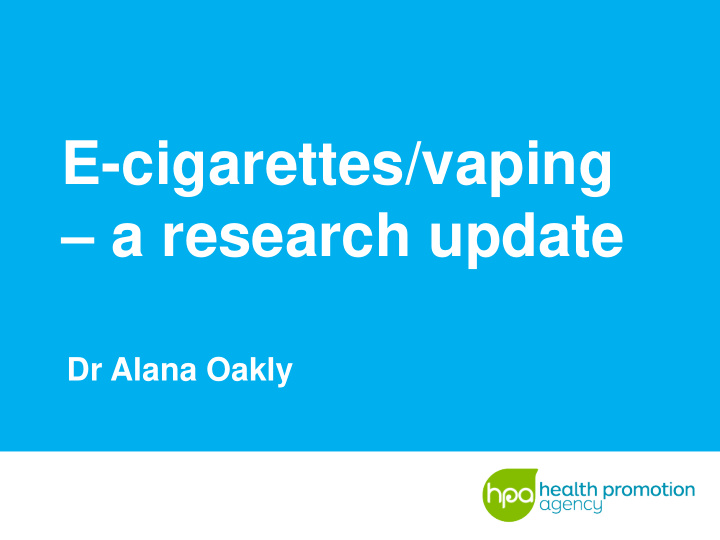



E-cigarettes/vaping – a research update Dr Alana Oakly
Vaping in New Zealand Source: 2016 Health and Lifestyles Survey (Health Promotion Agency)
Vaping in New Zealand Source: 2016 Health and Lifestyles Survey (Health Promotion Agency)
Top 5 reasons for vaping Source: 2016 Health and Lifestyles Survey (Health Promotion Agency)
Growth in search interest Source: Google Trends; retrieved 4/04/2018
Challenges for public health “The net public health effect, harm or benefit, of e-cigarettes [vapes] depends on three factors: 1. their intrinsic toxicity, 2. their effect on adult cessation of combustible products, 3. their effect on youth initiation of combustible products.” Source: NASEM (2018)
1. Toxicity and risk • Vaping is 95% less harmful than tobacco smoking, but research on long-term health effects is lacking. • No clear evidence that specific flavourings pose health risks. But there are suggestions that some could. • In some cases the content of the e-liquid is unknown and therefore so are the risks. • We don’t yet know whether maternal e-cigarette use affects foetal development. Source: Public Health England; Royal College of Physicians; American Cancer Society.
2. Smoking cessation • Vaping seems to be effective as a smoking cessation aid, but this based on a small number of studies. − A meta-analysis of randomised trials (one from NZ) found that participants using an e-cigarette were more likely to have abstained for at least 6 months than participants using a placebo (9% vs 4%). − From observational studies there is some evidence that more frequent use of e-cigarettes is associated with increased likelihood of smoking cessation. • Dual use of e-cigarettes and tobacco is an issue. Source: Cochrane Review, Hartman-Boyce et al., 2016
3. A gateway to smoking? • Substantial evidence that “never smokers” who try e-cigarettes are more likely to try smoking compared to those who have not tried e- cigarettes. − However, we don’t know if vaping causes smoking. It may be that something else leads to both behaviours, such as novelty seeking. • While some experimentation is common, regular use of e-cigarettes is relatively rare among young people who are “never smokers”. • E-cigarettes do not appear to be undermining the long- term decline in tobacco smoking among young people. Source: Public Health England, 2018; NASEM, 2018; 2016 HLS
Conclusions • The popularity of vaping is increasing • Current evidence suggests: 1. They are 95% less harmful than smoking tobacco 2. There is some evidence that they help people to quit smoking We currently don’t know whether vaping leads 3. youth to begin smoking • Further research is required
Recommend
More recommend